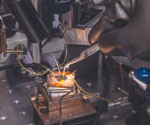Chemists discover a way to solder semiconductors
18 March 2015
Electronics Technology
A technique has been developed by University of Chicago, Argonne National Laboratory and Illinois Institute of Technology researchers to solder semiconductors, a breakthrough which may revolutionise printed electronics and possibly make 3D printing of semiconductor chips possible, amongst other exciting applications in the field of electronics.
From computer chips to solar cells, semiconductors conduct electricity and make it possible to generate and control electrical current. However, they cannot simply be joined together since they are very sensitive to impurities and structural defects.
“If you put two pieces of semiconductor next to each other, each joint will be unique, and in most cases, will block transport of charges,” explains research team leader and chemistry professor Dmitri Talapin. “You will not be able to make a reasonably good electronic circuit by simply taking different semiconductor pieces and pressing them against each other as you could do with metals.”
The compounds Talapin and company have developed change all that. Made of cadmium, lead and bismuth, they can be applied as a liquid or paste to join two pieces of a semiconductor by heating them to several hundred degrees Celsius, which is mild by industry standards. After application, they decompose to form a seamless joint.
“Our paste or our liquid converts cleanly into a material that will be compositionally matched to the bonded parts, and that required development of new chemistry,” Talapin says. “We had to design special molecules that fulfil this requirement so that they do not contaminate the material.” The team set a new record for electron mobility in solution-processed semiconductors, a measure for how quickly electrons move through the materials. The new record is almost 10 times faster than the old one.
Semiconductor soldering is unlikely to have a major impact on today’s mainstream process by which large silicon crystals are grown, then cut, carved and etched into the desired shapes. It could, however, lead to the development of less expensive, solution-processed semiconductors needed for entry into new markets. Among these markets are printable electronics, 3D printing, flat-panel display manufacturing, solar cells and thermoelectric heat-to electricity generators for the Internet of Things.
Further reading:
140 W USB-C PD reference design
Altron Arrow
Electronics Technology
The design has a wide input range of 90 to 264 V AC, 50-60 Hz, and supports an output voltage range of 5 to 28 V (USB-PD 3.1 specification).
Read more...
Nanometre-precision piezo actuators
RS South Africa
Electronics Technology
TDK Corporation has announced two new piezo actuators that are characterised by a wide dynamic range, a high force-to-volume ratio, but with precision in the nanometre range.
Read more...
Webinar: The evolving electrification of the power distribution system
Electronics Technology
New connected car functionality, along with the necessity to reduce the cost, weight and complexity associated with wire harnesses, has led to the transformation of the power distribution system in automotive engineering.
Read more...
Improved MnZn material for power conversion industry
Sivan Electronic Supplies
Electronics Technology
Cosmo Ferrites Ltd, a leading manufacturer of soft ferrites, has launched an improved version of CF295 for the power conversion industry.
Read more...
Common mode filter for automotive Ethernet
Avnet Abacus
Electronics Technology
TDK Corporation has announced the introduction of its new ACT1210E Series common mode filter for automotive Ethernet 10BASE-T1S.
Read more...
Energising the industrial edge
Electronics Technology
As if the drive to decarbonise energy as part of sustainability and climate change efforts was not enough, the recent rise in energy prices has brought into sharp contrast the need to re-examine how we generate, distribute, and consume electricity.
Read more...
Samsung begins chip production using 3 nm process technology
EBV Electrolink
Electronics Technology
The optimised 3 nm process with GAA architecture achieves 45% lower power usage, 23% improved performance and 16% smaller surface area compared to 5 nm process.
Read more...
Panasonic releases its updated touch-sensitive knob
Altron Arrow
Electronics Technology
Panasonic, in conjunction with Microchip, has launched an update to its existing Magic Knob, a capacitive knob ready for standard touch sensors for use in controlling automotive information displays.
Read more...
Microchip’s new IC to replace Hall effect position sensors
Altron Arrow
Electronics Technology
The LX34070 IC from Microchip is set to help accelerate the global move away from expensive and less accurate magnet-based solutions for safety-critical EV motor position monitoring.
Read more...
A brief history of HBTs
Conical Technologies
Electronics Technology
In 1947 the engineers at Bell Labs were tasked with developing a transistor. This development heralded the beginning of the semiconductor industry which changed the world forever. Transistors would have
...
Read more...


